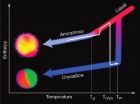Analysis of the chocolate genome could lead to improved crops and products
2010-09-17
(Press-News.org) The sequencing and analysis of the genome for the Criollo variety of the cacao tree, generally considered to produce the world's finest chocolate, was completed by an international team led by Claire Lanaud of CIRAD, France, with Mark Guiltinan of Penn State, and included scientists from 18 other institutions.
"The large amount of information generated by this project dramatically changes the status of this tropical plant and its potential interest for the scientific community," said Guiltinan, professor of plant molecular biology, Penn State.
The researchers not only sequenced the genome of this ancient plant, but assembled 76 percent of the genome linking 82 percent of those genes to the 10 cacao chromosomes. This analysis identified a variety of gene families that may have future impact on improving cacao trees and fruit either by enhancing their attributes or providing protection from fungal diseases and insects that effect cacao trees.
"Relics of the ancestral Criollo first cultivated by Olmec or Maya people can still be encountered in old Mesoamerican plantations or in forests where the Maya live," said Siela Maximova, associate professor of horticulture and a member of the research team. "Our genome sequence is derived form a Belizean Criollo plant collected in the Mayan mountains."
Cocoa production began in Mesoamerica 3,000 years ago, and the Criollo variety was the first domesticated. Because these trees self-pollinate, they are generally highly homozygous -- possessing two identical forms of each gene, making this particular variety a good choice for accurate genome assembly.
Although originally a new-world crop, cacao trees -- scientifically designated Theobroma cocao -- are now grown and cultivated in humid, tropical areas around the world. About 3.7 million tons of cocoa are produced annually worldwide and contribute greatly to the income of small farmers. Cacao trees, because they are grown in shade, are also ideal for environmental preservation because they contribute to diversity and land rehabilitation.
"We believe that Theobroma cacao is the first early domesticated tropical tree fruit crop to be sequenced," said Guiltinan. "Interestingly, only 20 percent of the genome was made up of transposable elements."
Transposable elements or transposons are one of the natural pathways through which genetic sequences changes. They do this by moving around the chromosomes, changing the order of the genetic material. Smaller amounts of transposons than average could lead to slower evolution of the chocolate plant.
Guiltinan and his colleagues are interested in specific gene families that could link to specific cocoa qualities or disease resistance. They hope that mapping these gene families will lead to a source of genes directly involved in variations in the plant that are useful for acceleration of plant breeding programs.
"We hope this achievement will encourage greater investment in research of Theobroma cacao, the 'food of the Gods' whose magic flavor has spread worldwide since the time of the Maya and Aztec civilizations, and whose continued study will benefit developing countries for which cocoa is of high economic importance," said Guiltinan.
A summary of the paper appears in Nature Precedings at http://precedings.nature.com/documents/4908/version/1
INFORMATION:
Penn State researchers involved in this study include Guiltinan and Maximova, department of horticulture; Yufan Zhang and Zi Shi, graduate students, plant biology; Stephen Schuster, department of biochemistry and molecular biology; John E. Carlson, School of Forest Resources and M.J. Axtell and Z. Ma, department of biology.
Other researchers involved were from CIRAD, Institut National de la Recherche Agronomique UMR, Universite d'Evry, INRA-CNRS LIPM Laboratoire des Interactions Plantes Micro-organismes, Universite de Perpignan, Unite de Biometrie et d'Intelligence Artificielle , Institut des Sciences du vegetal, Chocolaterie Valrhona, all in France.
Also included are researchers from the University of Arizona; Cold Spring Harbor Laboratory; Institute des Sciences du Vegetal, Ivory Coast; CEPLAC, Brazil and Centro Nacional de Biotecnologia Agricola, Instituto de Estudios Avanzados,Venezuela.
CIRAD, the Agropolis foundation, the Région Languedoc Roussillon, Agence Nationale de la Recherche (ANR), Valrhona, the Venezuelan Ministry of Science, Technology and Industry, Hershey Corp., the American Cocoa Research Institute Endowment and National Science Foundation supported this work.
ELSE PRESS RELEASES FROM THIS DATE:
2010-09-17
(Garrison, NY) As government support for personalized medicine grows, a consumer advocate, a patient, and bioethicists explore ethical controversies. Direct-to-consumer genetic tests, privacy, targeted cancer therapies, and Henrietta Lacks are among topics in a special issue of the Hastings center Report
Behind the high expectations raised by personalized medicine – the use of genetic information to individualize treatment, improve care, and possibly save money – a series of essays in the Hastings Center Report examines the challenges in determining what is effective; ...
2010-09-17
MANHATTAN, KAN. -- While natural food is a rising trend among humans, pet owners should be careful before feeding similar types of food to their pets, according to a Kansas State University veterinarian.
All too often pet owners assume that because certain foods, such as fruits and vegetables, are healthy for them, they are also healthy for their pets, said Susan Nelson, K-State assistant professor of clinical services.
"Natural and veggie-based pet foods are based more on market demand from owners, not because they are necessarily better for the pet," she said.
Natural ...
2010-09-17
The ability of phase-change materials to readily and swiftly transition between different phases has made them valuable as a low-power source of non-volatile or "flash" memory and data storage. Now an entire new class of phase-change materials has been discovered by researchers with the Lawrence Berkeley National Laboratory (Berkeley Lab) and the University of California (UC) Berkeley that could be applied to phase change random access memory (PCM) technologies and possibly optical data storage as well. The new phase-change materials – nanocrystal alloys of a metal and ...
2010-09-17
In 2008, Reuben Granich and his colleagues at the World Health Organization published a paper in the medical journal The Lancet that proposed a new strategy for combating HIV in South Africa, a country staggered by the virus, with as much as 18 percent of the population estimated to be infected.
Based on a mathematical model, the study suggested a "test-and-treat" strategy. This would involve, among other steps, testing the entire population of South Africa for HIV and immediately beginning anti-retroviral therapy for all who tested positive. The current standard of ...
2010-09-17
UCLA physicists have taken a significant step in controlling chemical reactions mechanically, an important advance in nanotechnology, UCLA physics professor Giovanni Zocchi and colleagues report.
Chemical reactions in the cell are catalyzed by enzymes, which are protein molecules that speed up reactions. Each protein catalyzes a specific reaction. In a chemical reaction, two molecules collide and exchange atoms; the enzyme is the third party, the "midwife to the reaction."
But the molecules have to collide in a certain way for the reaction to occur. The enzyme binds ...
2010-09-17
For the first time in more than ten years, there has been a confirmed sighting of one of the rarest and most mysterious animals in the world, the saola of Laos and Vietnam. The Government of the Lao People's Democratic Republic (also known as Laos) announced on September15 that in late August villagers in the central province of Bolikhamxay captured a saola and brought it back to their village. The animal died several days later, but was photographed while still alive.
This is the first confirmed record of the species since two photographs of wild saola were taken ...
2010-09-17
DALLAS – Sept. 17, 2010 – UT Southwestern Medical Center investigators have uncovered new insights on adolescent fighting: what triggers it, and how to stem it.
Varied real-life factors pile on daily to put teens on edge: destructive behaviors like drug abuse, drinking or high-risk sexual encounters; poverty; academic troubles; and even depression. Data analyzed by researchers at UT Southwestern suggests that when teens perceive support from their families and/or schools, it can help mitigate violence.
"Our findings tell us that it's unlikely that traditional cookie-cutter ...
2010-09-17
Terrorist networks are complex. Now, a mathematical analysis of their properties published this month in the International Journal of Networking and Virtual Organisations, suggests that the best way to fight them is to isolate the hubs within the network rather than trying to destroy the network as a whole through short-term battles.
According to Philip Vos Fellman a Lecturer at Suffolk University, Boston, and member of the New England Complex Systems Institute, USA, tools used to analyze complex systems can also be used to study terrorist networks with a view to undermining ...
2010-09-17
LIVERPOOL, UK – 17 September 2010: Research at the University of Liverpool could lead to faster and more accurate diagnoses of liver damage.
The team used paracetamol as the basis for the study: research indicates that paracetamol can place temporary stress on the liver in around a third of people who take a normal dose (4g per day) but the liver returns to normal when the drug has left the system. Overdoses of the drug are a major cause of liver failure in both the UK and US.
Scientists have discovered that the presence of specific proteins in the blood are indicative ...
2010-09-17
"A sedentary lifestyle has become one of the major public health problems in developed countries", Juan P. Rey-López, lead author of the study and a researcher at the University of Zaragoza (UNIZAR), tells SINC. "During the week, one-third of teenagers said the watched more than two hours of television per day. At weekends, this figure exceeds 60%".
The results, published in the July issue of the journal Preventive Medicine, show that teenagers devote more time to sedentary behaviour (in front of a screen) at the weekend.
The study, which forms part of the European ...
LAST 30 PRESS RELEASES:
[Press-News.org] Analysis of the chocolate genome could lead to improved crops and products


